
Maaaaaaaan, has this post been a long time in coming. A few years ago, LPer supergreatfriend was doing a series on the then-imminent closure of the Wii Shop, spotlighting games in danger of being lost (at least in terms of easy commercial access) once the shop went down. I got to this part in his coverage of the Virtual Console release of Ys Book I & II, and...well, take a look yourself, if you've played Lunar: The Silver Star. Don't a few things seem...familiar?
I then (eventually) set to playing Ys Book I & II and found the parallels with The Silver Star went further than attract mode visuals. Places and characters; artistic approaches; design elements; shot compositions in other cutscenes: Kei Shigema repurposed vast and significant tracts of the Ys property to create Lunar. He often did so to greater effect than Ys - Book I & II's story is extremely rudimentary - but the debt is undeniable and heavy.
Below lies my chronicle of the major...influences. Assembling this document heavily involved my continual nemesis, working with images, so it took freaking forever after my initial playthroughs. I snatched a number of screenshots from Valis77's TSS and EB longplays. I may have gotten a couple images from random Tumblrs mixed in here; mea culpa.





The quickest way to spot the depths to which Lunar draws from Ys to take a look at Ys: Book I & II's opening/attract mode. A number of memorable shots from Lunar: The Silver Star's cinematics were very obviously stolen from Ys, most notably the demon horde's red eyes flashing in the dark prior to their emergence, followed by a pan up their numbers to the enemy leader - as well as the shot of a blade slashing through the darkness before the reveal of the stalwart, sword-swinging red-haired hero, standing battle-ready. The origins of Lunar's love of pictoglyphic friezes can also be found here.




Other shot steals: the opening of the tale presaged by the image of a tower framed against a stormy sky racing with lightning; the red-haired young hero, looking out on the bow of the ship toward his next destination; the slow pan across a pictoglyphic frieze as images of elements of a group of legendary significance fade in and out.
(As you probably know if you're reading this, the background in Lunar is racing with lightning as in Ys; I just am remarkably skilled at taking screenshots when no lightning is on the horizon - just the big strike in the foreground.)
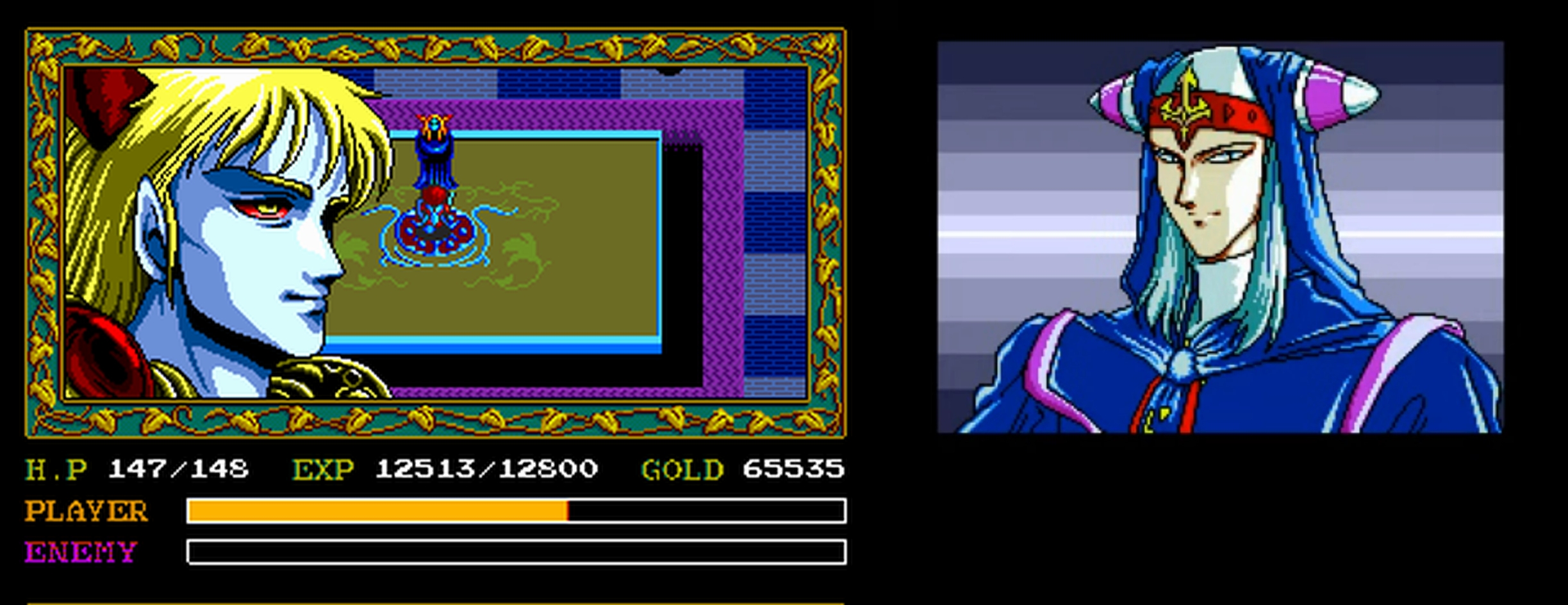
OK, here we go. Ghaleon being my favorite fictional character, my primary impetus for playing Ys: Book I & II was to see his roots, so to speak - his inspiration. I was notably disappointed.
The dark wizard fellow who takes Ghaleon's place in the equivalent Ys cinematic above is named Dark Fact. You're told that the land of Ys (a former utopia now vanished and imperiled for reasons that are initially a mystery) and its goddesses were guarded by six priests, one of whom was named "Fact." From this, and given the very strong parallels between Ys and Lunar, I logically concluded that Dark Fact was indeed that priest. Well, Ys gives what I had concluded to be its Ghaleon equivalent one and only one scene, his introduction before the final fight of Ys I, where he merely utters generic threats and does not mention his past or motivations at all. We learn nothing at all more on the Fact front until right before the final fight of Ys II, where one of the goddesses offhandedly remarks in an infodump that he was the descendant of one the priests, not the priest himself.
(The Dark Fact plot point is also further confused by his description in various resources on the game as a "ruined Ys priest," despite this seemingly having no correlation in the original game or manual. It's always in that curious wording, though, as if an official source is indeed being quoted. Subsequent media renditions of the Ys I & II tale apparently give Dark Fact a different backstory, so this isn't a case of retroactively applying newer material to older versions of the narrative.)
There are several layers of failures here - why did Dark Fact need to be connected to the priests of Ys at all if they weren't going to capitalize on it; if Dark Fact wasn't a priest whose fall was entwined with the disaster of Ys, as one might reasonably surmise, then who is this dude, and why did he turn evil in the first place - but as Lunar had better minds behind its story, it seems they wisely identified the missed opportunity here in a great hero from a group of guardians turning against the divine power and society he served, with the crisis of the story originating from that choice.
Bluntly, though: Ys does not have enough imagination or storytelling prowess to create anything like Ghaleon. It would be like asking an Atari 2600 to produce ray tracing. What Lunar did with Ghaleon is so superior to what Ys did with the concept that mentioning the connection is downright unfair to Ys.
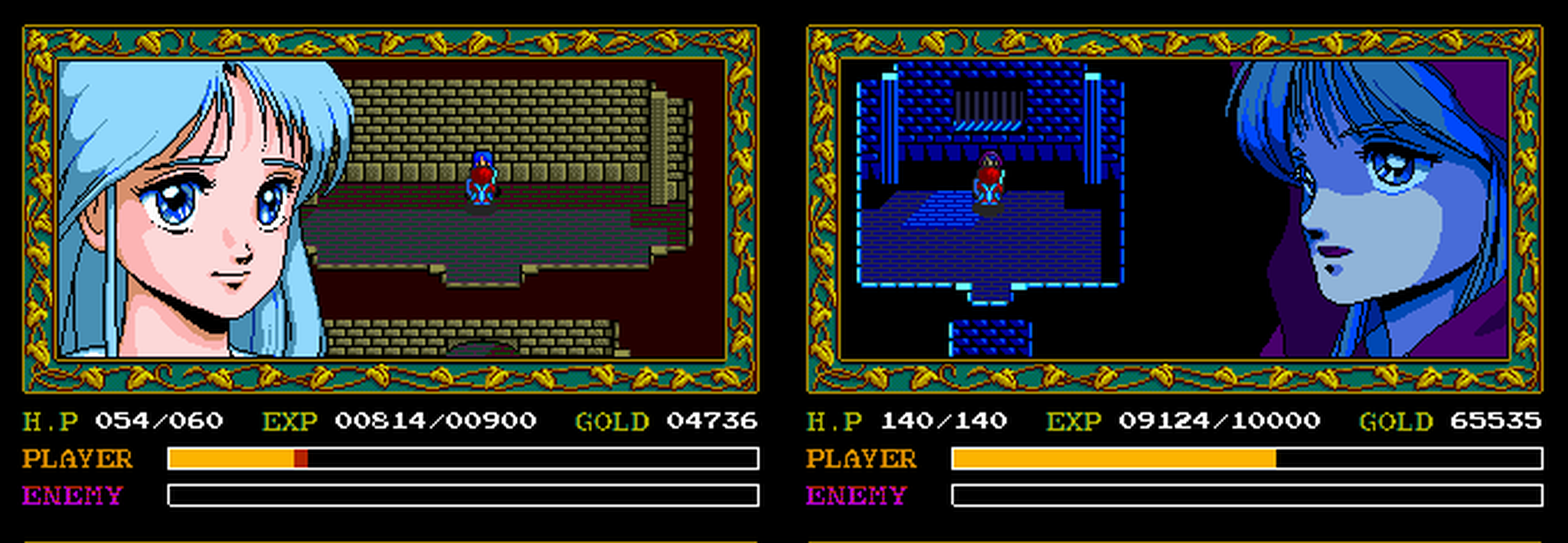

Feena and Lair, the twin blue-haired goddesses of Ys, are the obvious inspirations for Luna and Lucia, the blue-haired goddesses of Lunar and the Blue Star, right down to the slightly different shades of azure in their locks. Feena and Luna even seem cut from the same "naive farm girl whose inner goddess is taught how to love by the red-haired hero" cloth. (The wily Lair and the alien Lucia, not so much.)

In her restored-to-goddess state, however - nude in silhouette, framed by long blue hair - Feena echoes Lucia's initial appearance.

The lighting is not communicated well in still images, but a different shot of Feena - from the opening, of her staring into the camera in extremely tight close-up while backlit by blinding white light - seems to have inspired how Althena was shot in her recording in Eternal Blue.

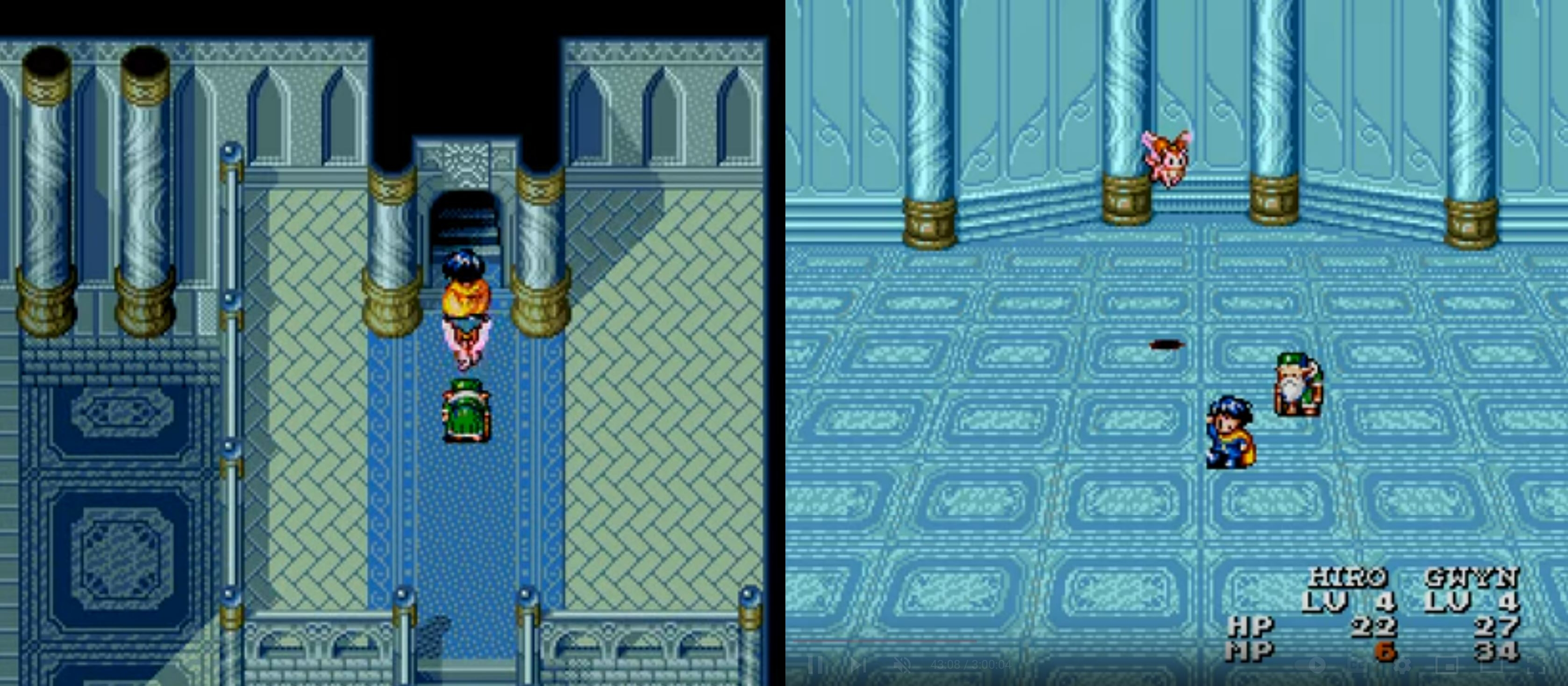
Even the goddesses' castle finds echoes in Lunar: its blue-tinged columns are revived in Lucia's Blue Spire, and the castle's fate - sealed behind the facade of the enemy fortress - is mimicked by that of the Goddess Tower in Lunar II.

(You could also argue that the Blue Spire's purpose as a skyscraping teleporter to another land in a higher plane is drawn from Darm Tower and its link to the floating land of Ys.)

While we're on the divine architecture beat, both franchises use blue faceless (from this perspective) stone goddess statues as important environmental items.

For that matter, we might as well note that Alex seems inspired by Adol, though, visually, this may be an example of red/blue contrast at work. (Er, Alex's hair is red in certain sprites.) Though the explanation merits an essay in itself, Alex and the original game's take on male-female relationships seems designed as a rebuke to Mr. Christin's endless wanderlust.
Alex's weird green shoulder-length shawl also seems taken from Adol's wardrobe. That deerstalker is all Shigema's fault, though.

One look at the final boss of Lunar II, and a question naturally arises: what's with that design? Well, this is what: it's stolen from the final boss of Ys II, at least in close-up, with the purple face enclosed by clamshell-like attachments on the sides. That doesn't answer where they got it, of course. (And there's no accounting for Zophar's hair.)

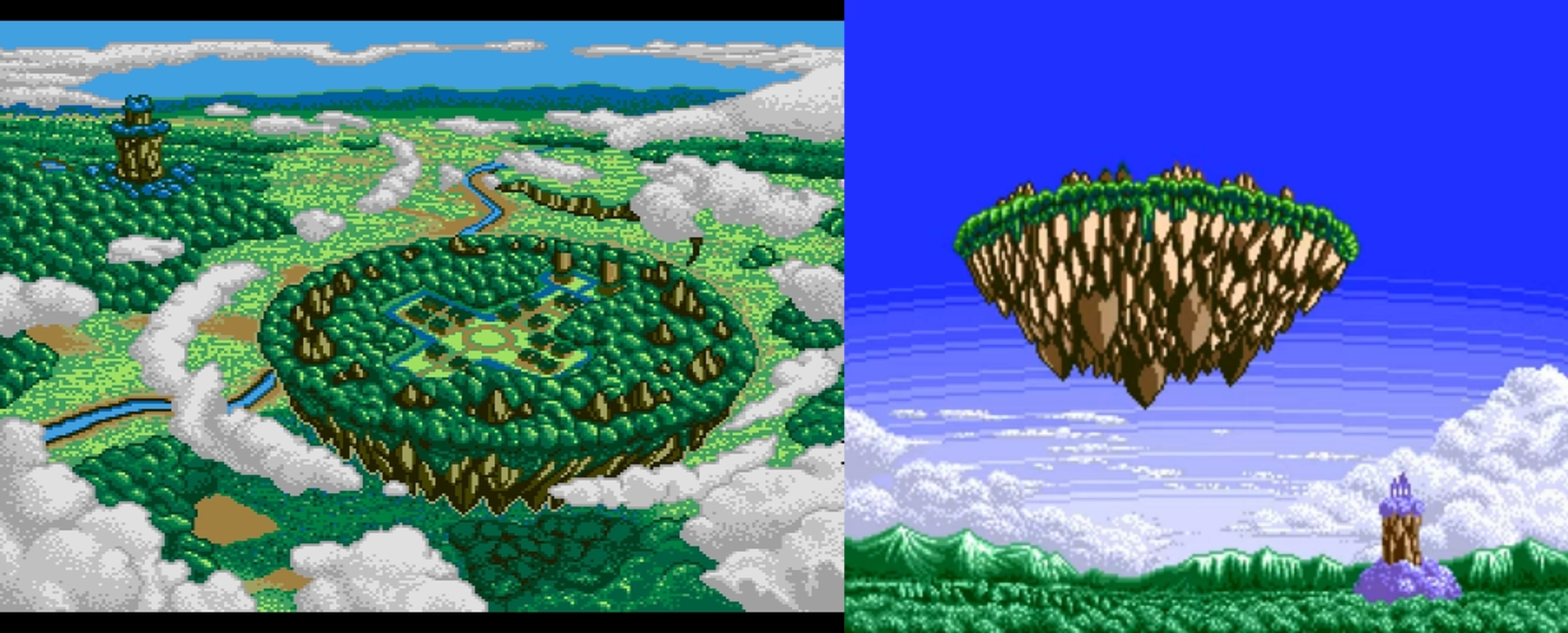
Vane doesn't have the prominence to the plot that Ys (shown grounded in the first pic) does in its eponymous game, and it's a city compared to a continent, but both are floating land masses that are home to an elevated culture, located next to a huge tower on a mesa connected to the domain of the divine. (In Ys, it's the monster-infested Darm Tower, which leads to Ys and its goddesses; in Lunar, it's the Goddess Tower.)

(ETA: Maou below astutely notes that requiring that the player use the harp to rescue Luna is, bizarrely, exclusive to the U.S. version. In the Japanese version, Luna will mention hearing Alex's harp as he ascends - but the player does not have to select it. An improvement on WD's end.)
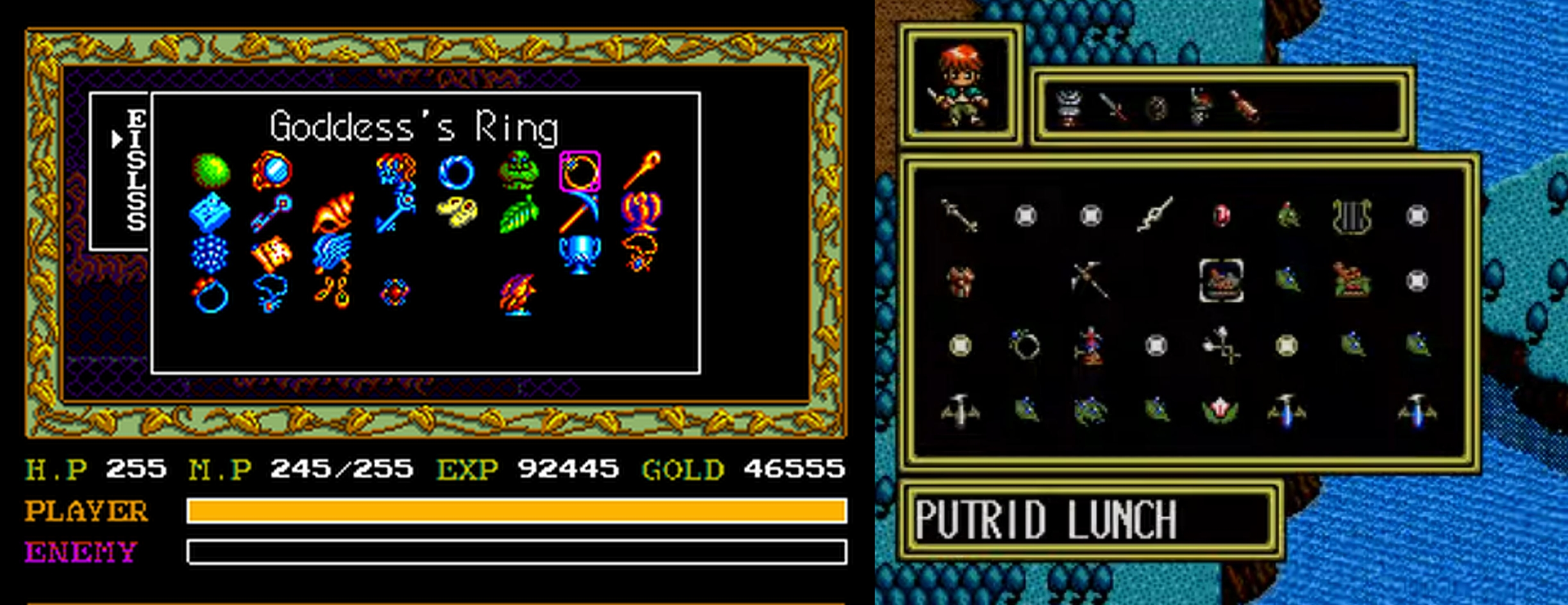
The theft doesn't stop at story elements; though Ys is action and Lunar is a turn-based RPG, it also encompasses gameplay elements. TSS's seemingly-unique inventory system - a big 8 x 4 square of pictorial icons representing items - is also taken from Ys.


This can't really be represented with screenshots since you need the overall map to see, but TSS also takes after Ys in its odd dungeon design - marked by dendritic passages, many ending in dead ends, very erratically blobby in shape for caves, oblong in buildings.

Finally, for something completely different and a bit more tenuous: the Phantasy Star III nurse - separated at birth from her Ys sister?
Look at that solid fungus-olive background in the right screenshot, by the way. Wow, PS3 made some palette choices.


Comments
With anime and games, certain hair colors are of course more likely to be used for certain character types (all the villainous types with long white hair being the prime example). I'd argue the parallels here are more specific than just having blue hair, though: a set of two goddesses, each in a slightly different shade, with one of each set bearing strong similarities in demeanor and her relationship to the hero, with defining scenes quoted visually. Likewise, the murals are used in very specific situations: the slow horizontal pan across a very long mural as the individual Heroes/Books of Ys fade in and out in turn in the attract mode; a distinctively deep-blue mural in the introduction illustrating the foundation of the world's faith and history and showing the goddess/es leading her/their people. Laputa may be the most influential example of the "floating fantasy land" concept, but Vane and the continent of Ys share geographic layouts vis-a-vis towers, divine significance, and ultimate fates. Given the sheer wealth of other visual quotes and plot-element parallels, I feel safe in concluding that though Ys may have been indeed influenced by more general trends, it is, to put it mildly, extremely likely that Lunar was influenced by Ys's specific iterations of those trends.
I didn't know that about TSS's ending, actually. Luna does mention, in her haze, hearing the sound of Alex's harp, but you don't have to play it in the Japanese version. A wise change on WD's part. I'll add note of this to the article.
Similarly, the Vheen/Ys parallel tracks more easily to Laputa: the Castle in the Sky, with Ghibli works of course being foundational for all Japanese fantasy.
The wall carving aesthetic as well belongs to Ghibli, and Nausicaa in particular. Like Tolkien in the West, these three sources are so omnipresent as to move from ripoff to "genre staple."
Note too that playing music to rescue Luna was a (clever) addition in the US version only.